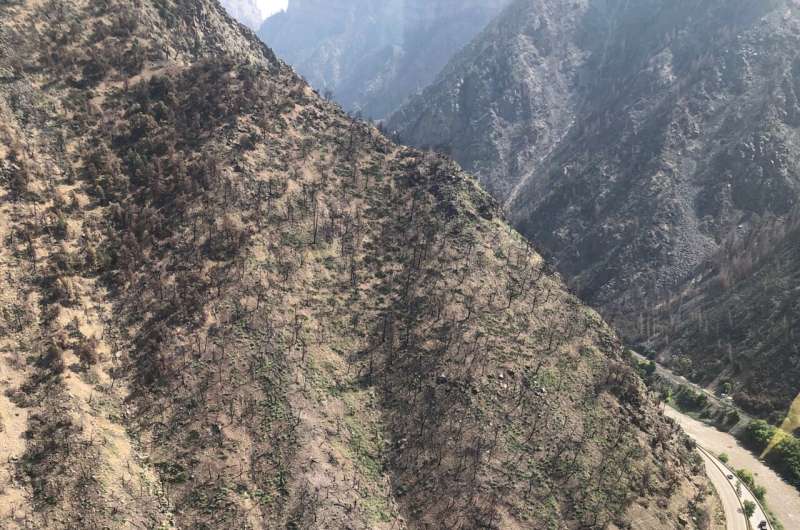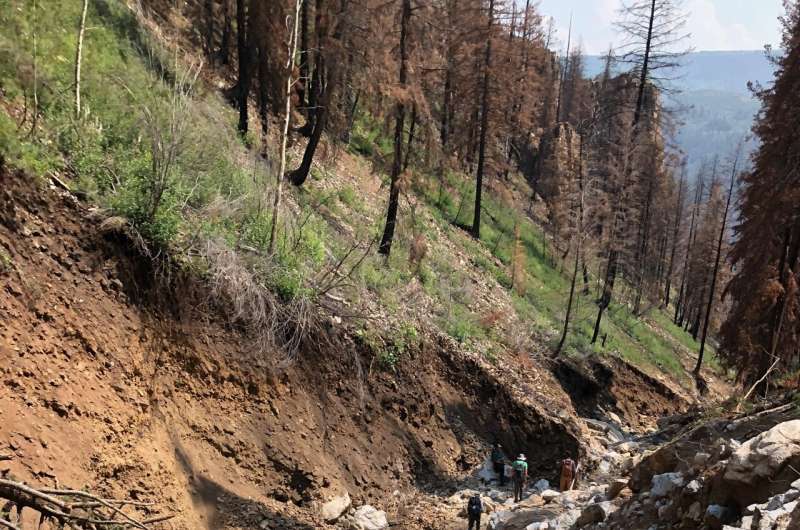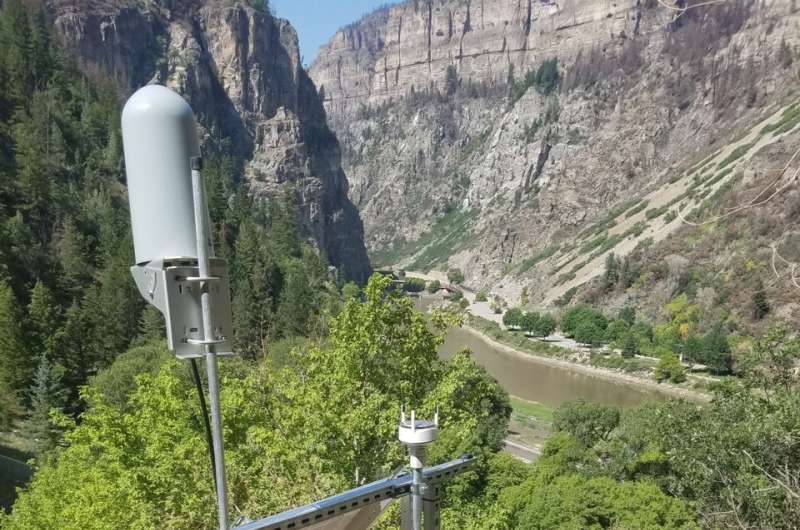This article has been reviewed according to Science X's editorial process and policies. Editors have highlighted the following attributes while ensuring the content's credibility:
fact-checked
trusted source
proofread
From ashes to alerts: Science helps protect Colorado travelers

In the summer of 2021, travelers in Colorado's Glenwood Canyon were safely evacuated before massive mounds of mud and rocks buried highways and destroyed bridges, thanks to a debris flow warning system developed in part by the U.S. Geological Survey. The system alerted Colorado Department of Transportation officials to intense rainfall events, providing crucial lead time for evacuations.
The warning system was put into place after the 2020 Grizzly Creek Fire ravaged the canyon, consuming more than 32,000 acres of forest, leaving behind a landscape primed for destructive debris flows. When rain falls on these fire-scarred areas, the precipitation can quickly transform into fast-moving slurries of mud, rocks and debris, posing a serious threat to people, property and the vital Interstate 70 corridor that threads through the heart of the canyon.
In the face of this looming threat, a team of USGS scientists embarked on a mission to predict post-fire debris flows. By combining cutting-edge technology, innovative research and collaborative partnerships, these experts are transforming the ashes of devastation into a system of early warning and protection.

Monitoring the burn area
After the fire, scientists installed a network of rain gauges and soil moisture sensors throughout the rugged burn area. These instruments provide real-time data on rainfall intensity and duration, which are critical factors in determining the likelihood of a debris flow.
"The more we understand about the factors that contribute to debris flows, the better equipped we are to predict their impacts," said Francis Rengers, USGS geologist and lead author of the study. "Our goal is to provide emergency managers and local authorities with the tools they need to keep the public safe."
Developing rainfall thresholds for safety
Scientists use models to estimate the rainfall amounts that might trigger debris flows based on site-specific information such as the intensity and duration of rainfall, burn severity and soil properties. Following storms, rainfall monitoring helps scientists refine the rainfall thresholds and test the accuracy of their prediction models for future events. This continuous monitoring and testing process ensures that early warning systems are as accurate and reliable as possible, giving emergency responders and the public the best chance to stay safe during potential debris flow events.

Collaborating for enhanced early warning
The National Weather Service adjusted these rainfall thresholds using their local knowledge of storms and compared them to forecasted rainfall to develop early warnings. Leveraging their expertise in weather forecasting and modeling, NWS meteorologists worked closely with USGS scientists to develop a state-of-the-art debris flow warning system. By combining rainfall data from the USGS gauges with sophisticated weather models, the system can issue alerts to communities and highway authorities in the path of potential debris flows.
"The collaboration between the USGS, CDOT and the National Weather Service has been instrumental in enhancing our ability to forecast and provide warning for these dangerous post-wildfire hazards," said Erin Walter, NWS service hydrologist. "By pooling our resources and expertise, we're able to provide a level of situational awareness and early warning that would be impossible for any one agency to achieve on its own."
Mapping the hazard zones
Another key aspect of the team's research involves the use of high-resolution laser mapping technology, known as lidar, to create detailed 3D maps of the canyon's terrain. By comparing lidar topographic maps from before and after the fire, scientists can pinpoint where debris flows started and calculate the total volume of material that was picked up and deposited by the flows.
These scientific tools allow researchers to test their current model to estimate debris flow volumes, which is critical for planning. Although the model overestimated observed volumes, the team gathered enough data to recalibrate the model for better precision in the future.
Protecting critical infrastructure
The debris flow warning system was put into action when scientists teamed up with the Colorado Department of Transportation. CDOT is charged with implementing measures to protect critical infrastructure in Glenwood Canyon.
"Our top priority is ensuring the safety of the traveling public and the surrounding communities," said Keith Stefanik, CDOT's chief engineer. "One way we are able to do that is by ensuring our infrastructure is resilient. By working hand-in-hand with the USGS and NWS, we've been able to take a proactive approach to mitigating the impacts of debris flows. From early warning systems to physical barriers, we're committed in our efforts to protect the canyon and the communities that rely on it."
Putting the system to the test
In the summer of 2021, approximately 6 months after the Grizzly Creek Fire had been contained, a series of intense monsoon storms battered the burn-scarred landscape. Rains triggered massive debris flows that buried highways, destroyed bridges, and choked the mighty Colorado River with tons of sediment. The economic impact was staggering, with transportation disruptions alone costing an estimated $1 million per hour.
The debris flow warning system successfully alerted CDOT officials to several intense rainfall events, allowing travelers to evacuate and avoid harm. While debris flows did occur, the road closure approaches used by CDOT helped to minimize danger to travelers.
Building a more resilient future
In the years to come, the lessons learned in Glenwood Canyon will ripple out across the West, informing and inspiring new partnerships, new innovations, and new strategies for living with the threat of post-wildfire debris flows. By working together, the USGS, NWS and CDOT are not only protecting lives and livelihoods in the short term but also building a foundation for a more resilient future in the face of a changing climate.
Provided by United States Geological Survey



















